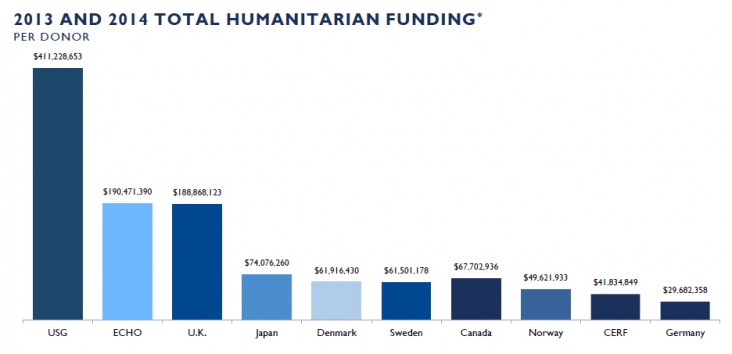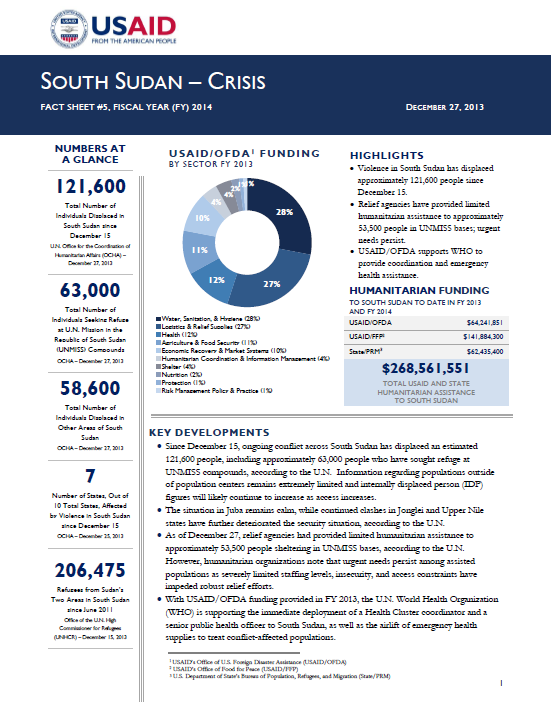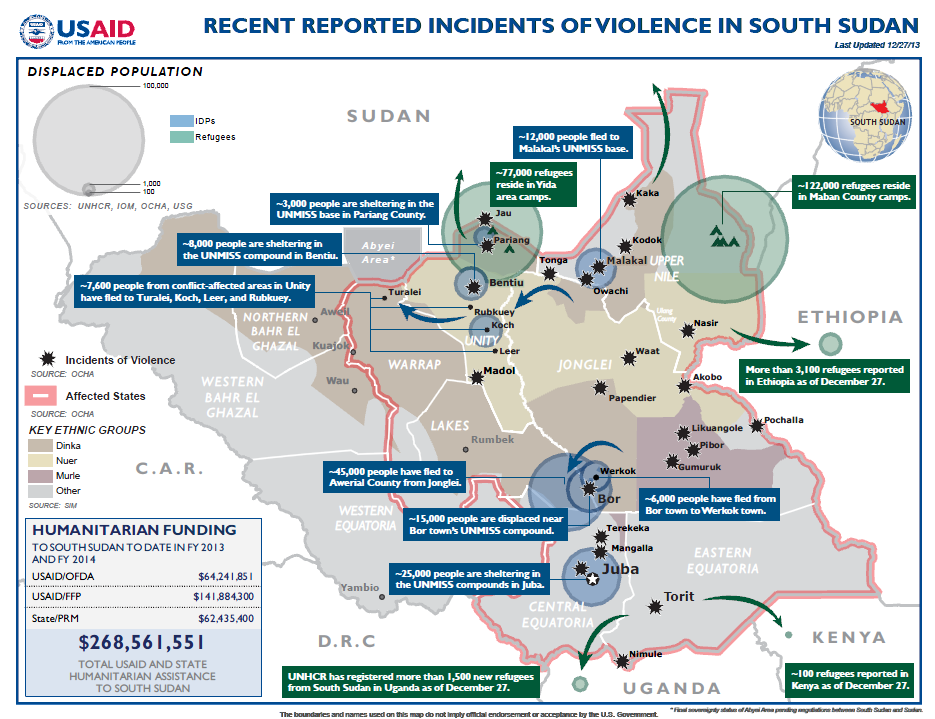- What We Do
- Agriculture and Food Security
- Democracy, Human Rights and Governance
- Economic Growth and Trade
- Education
- Environment and Global Climate Change
- Gender Equality and Women's Empowerment
- Global Health
- Humanitarian Assistance
- Transformation at USAID
- Water and Sanitation
- Working in Crises and Conflict
- U.S. Global Development Lab
Speeches Shim
April 11, 2014
Numbers At A Glance
817,700
67,800
749,900
280,600
236,700
Humanitarian Funding:
To South Sudan To Date In FY2013 and FY2014:
| USAID/OFDA | $120,608,953 |
| USAID/FFP | $180,884,300 |
| State/PRMDoD | $109,735,400 |
| TOTAL | $411,228,653 |
Highlights
At least 2,875 internally displaced persons (IDPs) have voluntarily relocated from UNMISS Tong Ping to U.N. House 3
Relief organizations reach more than 965,000 conflict-affected people with healthrelated assistance
Insecurity in Upper Nile State results in additional population displacement
KEY DEVELOPMENTS
Humanitarian organizations are increasingly concerned regarding severely deteriorating food security conditions in South Sudan. An estimated 7 million people are vulnerable to food insecurity, with 3.7 million people at high risk, according to the U.N. Malnutrition levels are also increasing, and the U.N Children’s Fund (UNICEF) estimates that 222,700 children may require treatment for severe acute malnutrition (SAM) in the coming months—more than double the number of children requiring treatment in 2013.
As the April-to-August rainy season intensifies, relief organizations are scaling up efforts to support infrastructure improvements and voluntary relocations at congested UNMISS bases to mitigate health and water, sanitation, and hygiene (WASH) risks associated with flooding and standing water.
In recent days, clashes in Upper Nile State near Melut town resulted in the displacement of approximately 103,000 people to Kodok, Lul, and Wau Shiluk towns. The fluid security situation continues to create challenges for relief organizations attempting to track and provide assistance to displaced populations.
U.N. agencies continue to expand activities in conflict-affected areas through the new Inter-Rapid Response Mechanism. Multi-sector teams are reaching populations with health, nutrition, child protection, and WASH support in remote areas, including Akobo town, Jonglei State; Mayendit and Nyal towns, Unity State; and Melut town, Upper Nile State.
INSECURITY, DISPLACEMENT, AND ACCESS CONSTRAINTS UPDATE
The security situation in South Sudan remains fluid, with insecurity particularly affecting populations in Jonglei, Unity, and Upper Nile states. According to the U.N., hostilities since December 15 have resulted in the displacement of nearly 1.1 million people—including 817,700 IDPs and approximately 280,000 people who are seeking refuge in neighboring countries. Since April 4, the number of IDPs in Jonglei and Unity has decreased; however, the number of IDPs in Upper Nile rose by 54 percent—from 88,500 to 136,600 people. While nearly 67,800 IDPs are sheltering at eight UNMISS bases in South Sudan, the majority of IDPs in the country are dispersed throughout remote areas where humanitarian access is limited.
In recent days, new clashes between the Government of the Republic of South Sudan (RSS) and opposition forces erupted near Upper Nile’s Melut town, resulting in additional population displacement, according to international media. As of April 10, some conflict-affected persons already displaced to sites near Melut were preparing to flee the area, according to the U.N.
HUMANITARIAN NEEDS ASSESSMENTS AND RESPONSE ACTIVITIES
Through a new rapid response mechanism, the U.N. Food and Agriculture Organization (FAO), UNICEF, and the U.N. World Food Program (WFP) continue to expand activities to reach populations in remote areas. Multi-sector response teams are conducting needs assessments and providing health, nutrition, child protection, and WASH support in Akobo town, Jonglei; Mayendit and Nyal towns, Unity; and Melut town, Upper Nile. Two additional rapid response teams have deployed to Kodok and Pagak towns, Upper Nile, and teams are planning to travel to Melut, as well as Jonglei’s Haat and Mathiang towns, in the coming days, according to UNICEF.
South Sudan Crisis Fact Sheet #37 April 11, 2014 ![]() (pdf - 382k)
(pdf - 382k)
South Sudan Crisis Map April 11, 2014 ![]() (pdf - 960k)
(pdf - 960k)
CAMP COORDINATION AND CAMP MANAGEMENT
The Camp Coordination and Camp Management (CCCM) Cluster—the coordinating body for camp coordination and management activities, comprising U.N. agencies, non-governmental organizations (NGOs), and other stakeholders—continues to facilitate the delivery of assistance to IDPs in displacement sites and to support voluntary IDP relocations, as security permits.
CCCM Cluster partners—led by USAID/OFDA partner International Organization for Migration (IOM) and UNHCR—are establishing humanitarian hubs for relief workers at displacement sites to provide crucial office and accommodation space for relief staff. As of April 11, humanitarian hubs were operational in Awerial County, Lakes State, and near Bor town, Jonglei.
As the rainy season strengthens, efforts to decongest the protection area at the Tong Ping base in Juba town, Central Equatoria State, are progressing, according to UNMISS. Following heavy rainfall in Juba on April 5 and 6, which resulted in flooding in some areas of Tong Ping, more than 1,000 individuals sheltering in the protection area volunteered to relocate to U.N. House 3. On April 7, more than 400 IDPs relocated from Tong Ping to U.N. House 3, marking the largest one-day population relocation since relocation began on March 12. As of April 7, with USAID/OFDA support, IOM had provided movement assistance to a total of 2,875 individuals who voluntarily relocated from Tong Ping to U.N. House 3.
Relief agencies remain concerned regarding congestion and resultant poor health, shelter, and WASH conditions at the IDP protection area in the Malakal UNMISS base and are working to urgently improve living conditions. On April 8, IOM began airlifting machinery and heavy equipment—including backhoes and tractors—to Malakal to expedite the improvement and expansion of the IDP site.
AGRICULTURE, FOOD SECURITY AND NUTRITION
As the rainy season intensifies, relief organizations are prioritizing the distribution of farming tools and crop seeds to help ensure these inputs reach farmers before the planting season ends. Other livelihoods response activities, such as the distribution of fishing kits and support of animal husbandry, will continue throughout the rainy season, according to relief organizations.
To date in 2014, relief organizations have provided food assistance to approximately 1.1 million people in South Sudan, including approximately 554,000 conflict-affected persons and 534,400 other food-insecure people, such as refugees.
With ongoing displacement, disrupted agricultural activities, and high food prices in many areas of the country, food insecurity is increasing. Market revitalization efforts face significant challenges, such as damaged or destroyed infrastructure, lack of traders, and a volatile security situation. Food Security and Livelihoods Cluster partners are working with RSS authorities to conduct food security surveys in South Sudan’s seven least-conflict-affected states. The Cluster has also conducted emergency food security assessments in 20 locations across Jonglei, Unity, and Upper Nile, and plans to share the results of the assessments in late April.
Humanitarian organizations are growing increasingly concerned regarding the deteriorating nutritional status of children in South Sudan. The nutrition security outlook in conflict-affected states is particularly dire due to planting, harvest, and market disruptions caused by persistent hostilities. UNICEF estimates that approximately 222,700 children will soon require treatment for SAM—more than double the number of children requiring treatment in 2013. In response, UNICEF has developed an emergency response strategy to scale up nutrition interventions in Jonglei, Unity, and Upper Nile, as well as in Northern Bahr el Ghazal and Warrap states.
Through the Inter-Rapid Response Mechanism, humanitarian organizations are providing nutrition services to vulnerable populations located outside of UNMISS bases. Between April 1 and 7, nutrition experts screened approximately 3,350 children and 5,500 children for malnutrition in Mayendit and Akobo, respectively, according to UNICEF. Relief workers provided Vitamin A supplements to approximately 1,370 children under five years of age in Akobo and conducted trainings on the management of acute malnutrition in Akobo, Mayendit, and Melut.
HEALTH AND WASH
Acute respiratory infections, acute watery diarrhea, and malaria currently account for the highest morbidity levels among IDPs in locations surveyed by the South Sudan Early Warning and Disease Surveillance system—a joint project between the U.N. World Health Organization (WHO) and the RSS Ministry of Health. Relief actors are intensifying health education activities, providing house-to-house demonstrations of water treatment, and distributing point-of-use water treatment chemicals. In Bentiu town, Unity, humanitarian organizations plan to drill an additional borehole, and the International Rescue Committee (IRC) established oral rehydration treatment centers and is conducting individualized counseling on the importance of safe drinking water.
As hostilities continue and the rainy season strengthens, relief organizations plan to vaccinate additional conflict-affected populations against diseases, such as cholera, measles, and polio. Between March 31 and April 4, health partners completed a second round of oral cholera vaccinations at U.N. House 3, reaching approximately 5,800 vulnerable individuals, according to WHO. Between April 3 and 9, health teams operating at the UNMISS base in Bentiu town, Unity, administered polio vaccinations for 516 children and measles vaccinations for 420 children. Meanwhile, health facilities in Bentiu have begun to provide routine immunization services, as the security situation has stabilized, according to WHO.
In addition, the RSS Ministry of Health, with support from UNICEF, WHO, and other partners, is planning to provide measles and polio vaccinations, as well as Vitamin A supplements, to approximately 2.3 million children. The planned vaccination campaign, which is set to begin in late April, will target children in seven of South Sudan’s 10 states.
The Health Cluster reports that relief organizations have reached approximately 965,000 people—including IDPs and host communities—with health-related assistance since hostilities erupted in December. The lack of secondary health care services due to damaged infrastructure and funding shortages, as well as limited availability of mental health and psychosocial support, particularly for displaced people, continues to hinder response efforts, according to the U.N.
LOGISTICS AND RELIEF COMMODITIES
During March, the Logistics Cluster transported nearly 190 metric tons (MT) of humanitarian supplies via air to 13 locations in Jonglei, Lakes, Unity, and Upper Nile. The commodities—delivered on behalf of 17 relief organizations—included fuel, as well as agriculture, health, nutrition, shelter, and WASH supplies.
In early April, the first WFP convoy to successfully utilize the Gambella corridor—a road transportation route between Gambella Region, Ethiopia, and Upper Nile State—delivered nearly 170 MT of food to IDPs in Pagak town, Upper Nile, according to WFP. A second WFP convoy then delivered approximately 390 MT of food commodities to vulnerable populations in Maiwut town, Upper Nile. WFP plans to conduct a third convoy in the coming days to deliver additional food commodities to Mathiang town, Upper Nile, although the security situation remains volatile.
PROTECTION
As of April 10, relief actors had provided protection-related services to approximately 322,000 conflict-affected people. In 2014 to date, organizations have provided emergency child protection services to nearly 20,300 children. Despite ongoing activities, relief agencies must expand child protection activities outside UNMISS bases, according to the U.N.
Rapid response teams comprising staff from FAO, UNICEF, and WFP have distributed relief supplies and gathered data on the status of vulnerable individuals, including women and children, in Akobo, Mayendit, Melut, and Nyal. During the visits, humanitarian workers identified more than 400 separated and unaccompanied children and are currently providing family reunification services, when appropriate.
Since hostilities erupted, the monitoring and reporting mechanism (MRM)—a tool to provide timely and reliable information on children’s rights violations managed by a country-based task force and co-led by UNICEF—has reported more than 240 incidents of grave child rights violations in South Sudan. This statistic is particularly concerning when compared with the 17 incidents the MRM reported during the last quarter of 2013.
OTHER HUMANITARIAN ASSISTANCE
To date, international donors have provided approximately $463 million—more than 36 percent of the $1.27 billion total requested funding—to support humanitarian activities through the South Sudan Crisis Response Plan. Humanitarian partners have identified that a minimum of $232 million is necessary to maintain current service levels and prevent a severe deterioration of humanitarian conditions in the next three months, according to the U.N.
In early April, the Government of Canada announced it would provide additional humanitarian assistance to support emergency response activities in South Sudan.

*Funding figures are as of March 28, 2014. All international figures are according to OCHA’s Financial Tracking Service (FTS) and based on international commitments during the 2013 and 2014 calendar years. USG figures are according to the USG and reflect the most recent USG commitments based on the 2013 fiscal year, which began on October 1, 2012, and ended September 30, 2013, as well as the 2014 fiscal year, which began on October 1, 2013.



Comment
Make a general inquiry or suggest an improvement.